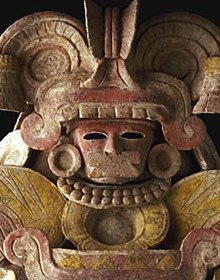let the objects speak
Teotihuacan - Incense Burner - In the Object's Own Words

Form
Normally, I sit quietly in my display case while I'm being admired by museum visitors, however, since I have your attention, I think I'll take this opportunity to tell you a little bit more about myself and my life story.
I am made of low-fired clay. I am actually two separately made pieces that fit together to form a censer, or ritual incense-burner. I may have been fired all at once, or in two operations, one to harden my body and another after the addition of my lid ornaments. My lid is fashioned with two handles that were added when my clay was not quite fully hard. My face and body were made of clay pressed into a wooden or pottery mould. Later my ear ornaments, bead necklace, circular disks, panels, and other adornments were attached with ceramic paste to give me extra pizzazz.
Function
I was designed to represent the Butterfly God. Along with this glory, I come from the famous and powerful city of Teotihuacan. My fellow censers and I were clearly of great importance to people who lived in that great centre in the Valley of Mexico. I was made during the Middle Classic period, when censers like me were popular religious items. Later, other cultures such as the Toltec in the north and the Mixtec in the south began to use representations of the Butterfly God with fertility symbols and images of the natural world.
Interment
Scholars know that I came from Teotihuacan because I have a distinctive butterfly nose ornament and 'wings' on my chest. The fact that I have survived the last 1400 years or more with all of my ornaments and my body intact is a real testament to the skill of the potter who made me. My butterfly god is related to the funerary world, and censers like me, as well as other butterfly depictions, are often found with buried nobles. Some believe that my butterfly god acted as a patron and protector of ambassadors and traders.
Rediscovery
Censers just like me have recently been found on the Pacific slopes in Guatemala, very far away from Teotihuacan. During the Classic period the people of Teotihuacan sent incensarios of my kind, as well as many other sorts of goods, to faraway lands as gifts to nobles and as merchandise to trade. By studying how widespread we censers and other things are, archaeologists discover the extent of the great city's religious, economic, and political influence.